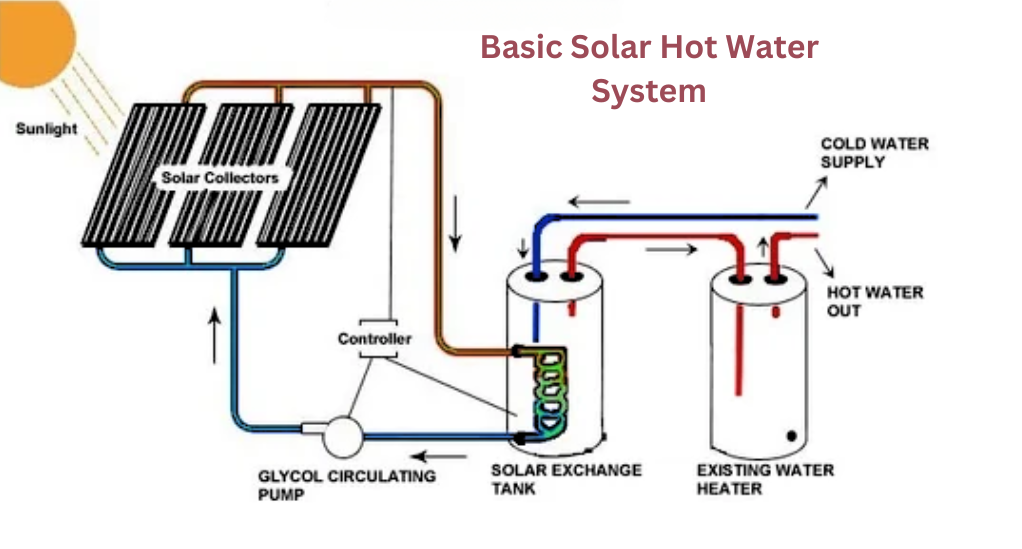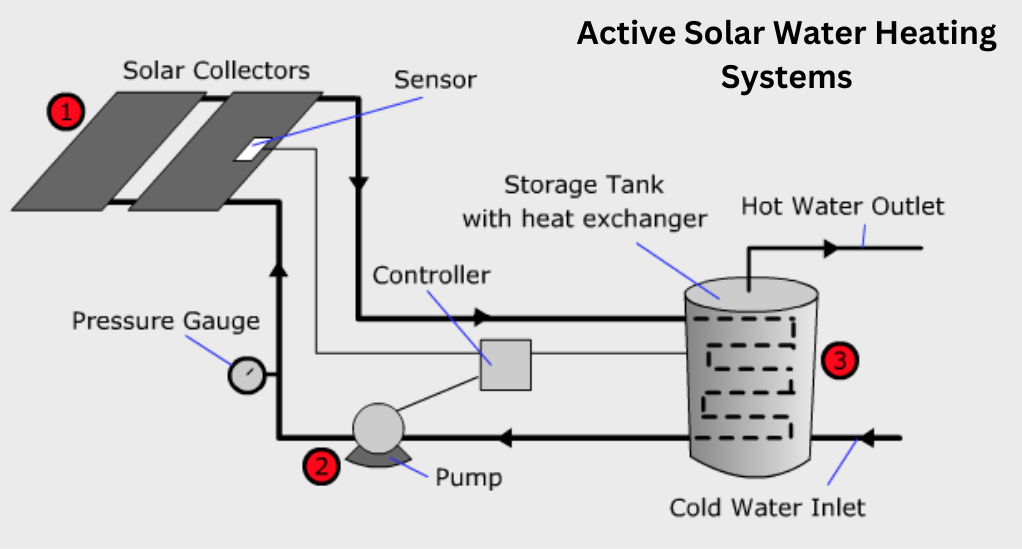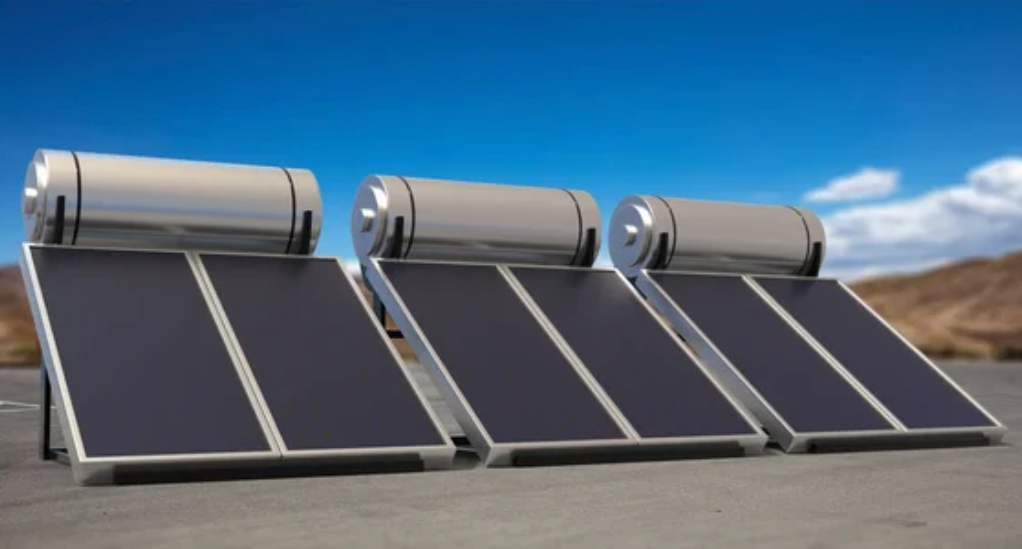In recent years, the world has witnessed a significant shift towards renewable energy sources, with solar energy standing at the forefront of this revolution. Solar energy, harnessed from the sun’s rays, presents an eco-friendly and sustainable alternative to conventional energy sources. It not only helps in reducing the carbon footprint but also cuts down energy bills substantially.
The utilization of solar energy isn’t confined to generating electricity; it extends to various applications, including water heating. Solar water heaters have emerged as a popular choice among homeowners seeking to make a green energy transition. Before we delve deeper into the intricacies of solar water heaters, let’s take a moment to understand the broader spectrum of solar energy.

A Brief History of Solar Energy
Solar energy has been utilized in various forms for centuries, from using sunlight to light fires to the development of solar cells capable of converting sunlight directly into electricity. The modern era of solar energy began in the mid-20th century with the invention of the silicon solar cell in 1954. This marked the beginning of a journey towards harnessing solar energy more efficiently and effectively.
The Current Scenario
Today, solar energy is harnessed through various technologies, including photovoltaic cells and solar thermal collectors. The global push towards renewable energy sources has led to significant advancements in solar technology, making it more accessible and affordable for the average homeowner.
Importance of Solar Water Heaters
Solar water heaters have become a cornerstone in the renewable energy landscape. These systems utilize the sun’s energy to heat water, providing a cost-effective and environmentally friendly solution for your home’s hot water needs. Let’s explore why solar water heaters are gaining prominence and how they stand as a testament to the innovative use of solar energy.
Environmental Benefits
- Reduction in Greenhouse Gas Emissions: By relying on the sun’s energy to heat water, solar water heaters help in reducing greenhouse gas emissions, which are a significant contributor to climate change.
- Conservation of Natural Resources: Utilizing solar energy means less reliance on non-renewable energy sources, thus conserving natural resources for future generations.
Economic Benefits
- Cost-Efficiency: After the initial investment in setting up the system, the operational costs are minimal since the fuel (sunshine) is free and abundant.
- Energy Bill Savings: Solar water heaters can significantly reduce your energy bills by decreasing the dependence on conventional water heating methods that consume a large amount of electricity or gas.
Enhancing Energy Security
By adopting solar water heaters, you contribute to reducing the demand for electricity from the grid, enhancing energy security by decreasing dependence on fossil fuels and mitigating the risks associated with fluctuating energy prices.
How to Use Solar Energy to Heat Water
Harnessing solar energy to heat water is a process that combines innovation with simplicity. In this section, we will guide you step-by-step through the principles and procedures involved in setting up and using a solar water heating system.
Basic Principles
Solar Radiation
Solar water heaters operate by capturing solar radiation, which is a type of energy emitted by the sun. This radiation is harnessed using solar collectors, which are specially designed to absorb the sun’s rays and convert them into heat energy.
Heat Transfer
Once the solar radiation is captured, the next step is transferring the heat to the water. This is achieved through a series of components working together, including solar collectors, heat exchangers, and storage tanks.
Storage
After the water is heated, it is stored in insulated tanks to retain the heat. These tanks are equipped with outlets and inlets that facilitate the circulation of water through the system, ensuring a steady supply of hot water.
Step-by-Step Guide
Step 1: Site Evaluation
Before installing a solar water heater, it is essential to evaluate the site’s solar resource. This involves assessing the amount of sunlight available throughout the year and determining the best location for the installation of solar collectors.
Step 2: Choosing the Right System
Based on the site evaluation, choose a solar water heating system that suits your needs. There are various types of systems available, each with its unique features and benefits. We will explore these in detail in the upcoming sections.
Step 3: Installation
Once you have chosen the right system, the next step is installation. It is recommended to hire a qualified solar thermal systems contractor to ensure the proper setup of the system, adhering to local building code requirements and safety standards.
Step 4: Maintenance
After the installation, maintaining the system is crucial to ensure its smooth operation. Regular maintenance includes checking the system components and cleaning the solar collectors to ensure optimal performance.
Step 5: Enjoying the Benefits
With the system in place, you can now enjoy the numerous benefits of having a solar water heater, including reduced energy bills and a smaller carbon footprint.
Components of a Water Heater for a Solar System
Understanding the components of a solar water heating system is crucial in grasping how these innovative systems function. In this section, we will dissect the various components that come together to form an efficient solar water heating system.

Solar Collectors
Solar collectors are the heart of the solar water heating system. They absorb sunlight and convert it into heat energy. Let’s explore the different types of solar collectors available:
1. Flat-Plate Collector
- Glazed Flat-Plate Collectors: These are insulated, weatherproofed boxes containing a dark absorber plate under one or more glass or plastic covers. They are highly efficient in absorbing solar energy.
- Unglazed Flat-Plate Collectors: Typically used for solar pool heating, these collectors have a dark absorber plate without a cover or enclosure, making them more affordable but less efficient compared to glazed collectors.
2. Integral Collector-Storage Systems
Also known as ICS or batch systems, they feature one or more black tanks or tubes in an insulated, glazed box. The cold water first passes through the solar collector, which preheats the water before it moves on to the conventional backup water heater.
3. Evacuated-Tube Solar Collectors
These collectors feature parallel rows of transparent glass tubes, each containing a metal absorber tube attached to a fin. The fin’s coating absorbs solar energy but inhibits radiative heat loss, making them highly efficient, especially for commercial applications.
Storage Tanks
Storage tanks are essential components that store the heated water until it is needed. Here are the different types of storage systems:
- One-Tank Systems: In these systems, the backup heater is combined with the solar storage in a single tank, providing a compact solution for homes with limited space.
- Two-Tank Systems: In two-tank systems, the solar water heater preheats water before it enters the conventional water heater. This setup allows for a larger volume of water to be heated and stored, catering to households with higher hot water demands.
Heat Exchangers
Heat exchangers play a vital role in transferring the heat from the solar collectors to the water. They come in various designs and configurations, each suited for different types of solar water heating systems.
Direct Circulation Systems
In these systems, pumps circulate household water through the collectors and into the home. They work well in climates where it rarely freezes.
Indirect Circulation Systems
These systems feature pumps that circulate a non-freezing, heat-transfer fluid through the collectors and a heat exchanger. This heats the water that then flows into the home, making them popular in climates prone to freezing temperatures.
Solar Powered Water Heaters
Solar powered water heaters have revolutionized the way we heat water, offering a green and sustainable solution. In this section, we will explore the different types of solar water heating systems, their working principles, and the benefits they bring to the table.
How They Work?
Solar powered water heaters work by converting sunlight into heat energy, which is then used to heat water. The basic setup involves solar collectors, a heat transfer system, and a storage tank. Depending on the system’s complexity, it may also include pumps, controllers, and a backup heater. Here, we delve deeper into the two primary categories of solar water heating systems: active and passive.
Active Solar Water Heating Systems
Active systems use pumps and controls to circulate water or a heat-transfer fluid through the solar collectors. These systems are generally more efficient and offer better performance compared to passive systems. They are categorized into two types:
- Direct Circulation Systems: These systems circulate household water directly through the solar collectors and into the home. They are suitable for regions where it rarely freezes.
- Indirect Circulation Systems: In these systems, pumps circulate a non-freezing, heat-transfer fluid through the collectors and a heat exchanger. This heats the water that then flows into the home, making them ideal for regions prone to freezing temperatures.

Passive Solar Water Heating Systems
Passive systems, on the other hand, do not use pumps or controls, relying instead on natural convection or gravity to circulate water through the system. Though they might be less efficient compared to active systems, they are more reliable and have a longer lifespan. They are categorized into two types:
- Integral Collector-Storage Passive Systems: These systems consist of a storage tank housed in an insulated, glazed box, allowing the sun to heat the water directly. They are best suited for areas with mild freeze conditions and households with significant daytime and evening hot-water needs.
- Thermosyphon Systems: In these systems, water is heated in a collector on the roof, and it flows through the plumbing system when a hot water faucet is opened, relying on gravity to circulate the water. These systems generally have a 40-gallon capacity.
Benefits and Advantages
Adopting a solar powered water heater comes with a plethora of benefits, which include:
- Environmental Conservation: By reducing reliance on fossil fuels, these systems help in lowering greenhouse gas emissions and conserving natural resources.
- Cost Savings: After the initial setup, the operational costs are minimal, leading to significant savings on energy bills in the long run.
- Energy Independence: Utilizing solar energy reduces dependence on the grid, enhancing energy security and mitigating the risks associated with fluctuating energy prices.
- Incentives and Rebates: Many regions offer incentives and rebates to encourage the adoption of solar water heating systems, making it a financially attractive option.
What Type of Thermal Energy is Used for Solar Water Heaters
Understanding the types of thermal energy utilized in solar water heaters is pivotal in grasping the functionality and efficiency of these systems. In this section, we will explore the various forms of thermal energy harnessed in solar water heating systems, providing a deep insight into this green technology.
Solar Thermal Energy: The Heart of Solar Water Heaters
Solar water heaters primarily utilize solar thermal energy, a form of energy harnessed from the sun’s rays. This energy is captured and converted into heat, which is then used to warm water for household use. Let’s delve deeper into the intricacies of solar thermal energy:
Solar Radiation
Solar radiation is the energy emitted by the sun in the form of electromagnetic waves. This radiation is captured by solar collectors in solar water heating systems, initiating the process of water heating.
Absorption and Conversion
Once the solar radiation reaches the solar collectors, it is absorbed by the absorber plates or tubes. These components are specially designed to absorb maximum radiation and convert it into heat energy.
Types of Solar Collectors
Solar collectors are the primary components responsible for capturing and converting solar radiation into thermal energy. Here, we explore the different types of solar collectors used in solar water heating systems:
Flat-Plate Collectors
These collectors feature a flat, dark-colored plate that absorbs solar radiation and converts it into heat. They are generally used in domestic solar water heating systems due to their efficiency and affordability.
Evacuated-Tube Collectors
These collectors consist of a series of evacuated tubes that capture and concentrate solar radiation, converting it into heat with high efficiency. They are suitable for commercial applications due to their higher temperature capabilities.
Integral Collector-Storage Systems
Also known as batch systems, these collectors combine the collector and storage tank into a single unit, simplifying the design and reducing costs.
Installation and Maintenance of Solar Water Heating Systems
| Step | Sub-Step | Description |
|---|---|---|
| Step 1: Finding the Right Installer | Research and Recommendations | Conduct thorough research on potential installers and seek recommendations from acquaintances who have adopted this technology. |
| Experience and Expertise | Choose an installer with substantial experience in installing the specific type of system you are considering. | |
| Licensing and Certification | Verify the installer’s licenses and certifications through relevant local bodies. | |
| References and Reviews | Request references and look for online reviews to gauge the installer’s reputation. | |
| Step 2: Planning the Installation | Lite Assessment | The installer evaluates the solar resource at your site and determines the optimal location for the solar collectors. |
| System Sizing | Determine the appropriate system size based on your household’s hot water demand and the local climate. | |
| Obtaining Permits | Obtain the necessary permits to ensure compliance with local codes and regulations. | |
| Step 3: Installation Process | Installing Solar Collectors | Set up the solar collectors in a location where they receive maximum sunlight, with correct orientation and tilt. |
| Setting Up the Storage Tank | Install and adequately insulate the storage tank to prevent heat loss. | |
| Installing the Heat Exchanger | Install the heat exchanger, facilitating the transfer of heat from the heat transfer fluid to the water. | |
| Connecting the Circulation System | Set up the circulation system to facilitate the heating process. | |
| Step 4: System Startup and Testing | Filling the System | Fill the system with water or the heat transfer fluid, as applicable. |
| System Startup | Start the system, initiating the circulation of the fluid and the heating of the water. | |
| Testing | Conduct tests to ensure the system is operating correctly, checking for leaks and verifying the water temperature. | |
| Step 5: Maintenance | Regular Inspections | Conduct regular inspections to check the system components and clean the solar collectors. |
| Professional Maintenance | Have the system serviced periodically by a professional to ensure its longevity and optimal performance. | |
| Troubleshooting | Consult a professional service provider for troubleshooting and rectifying any issues, ensuring efficient operation. |
Conclusion
Embarking on the journey to install a solar water heating system is a significant stride towards fostering a sustainable and environmentally friendly lifestyle. This comprehensive guide has aimed to illuminate the intricate facets of this technology, from understanding the core principles of thermal energy harnessed in these systems to the detailed steps involved in installation and maintenance. As you stand on the cusp of this green transition, equipped with knowledge and insights, you are prepared to make informed decisions that align with your specific needs and preferences.
The process of selecting the right system and a reliable installer is a critical pathway that leads to a successful and smooth transition to utilizing solar energy. A well-planned installation process, complemented by regular maintenance, promises a system that not only caters to your household’s hot water needs but also contributes positively to the environment. As you delve into this venture, remember that meticulous research and planning are the cornerstones that will shape a successful and efficient solar water heating setup in your home.
In conclusion, adopting a solar water heating system is a testament to human ingenuity and innovation, offering a sustainable solution to daily water heating needs. This guide serves as your companion in this green revolution, steering you towards a future where energy is harnessed harmoniously with nature. As you step into this new era, we hope this guide serves as a beacon, guiding you to a future where our homes resonate with the environment, fostering a world that thrives on sustainability and innovation.

